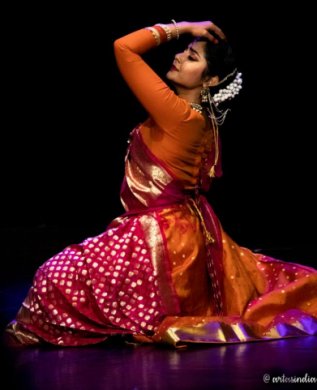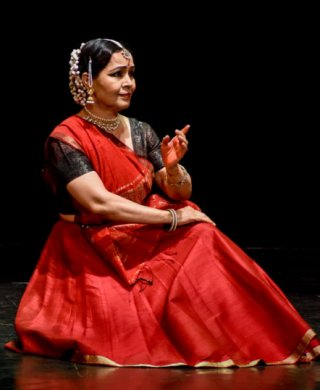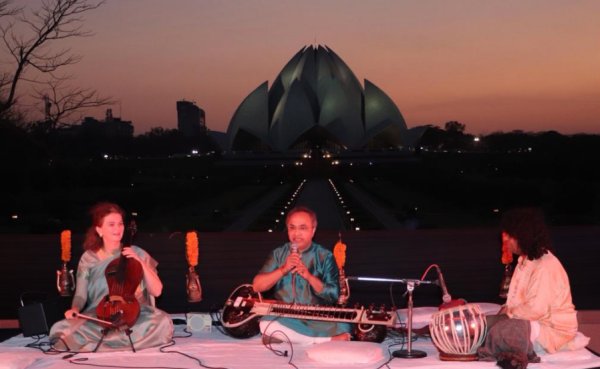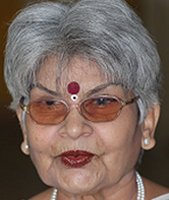
|   |

|   |
An incessant flow of colours - Manjari Sinha e-mail: manjari@sinha.com March 26, 2023 Kalaagat Niranjan Foundation presented 'Aviral Rang: Vivid Colours of Tradition' at the Stein auditorium conceived and choreographed by Guru Malti Shyam, as a tribute to her Guru Pt. Birju Maharaj. Malti is one of those deserving disciples of the late maestro, who has not only imbibed his delicate grace, rhythmic virtuosity and extraordinary aesthetic sense in her own dance but has also carried forward this precious tradition as a dedicated educator, through her institution the Kalaagat Niranjan Foundation. Malti Shyam had conceived it as a bouquet of her own solo, duet and group choreographies based on the compositions of Pt. Birju Maharaj, as an offering to her Guru and his esteemed tradition, the Guru-Shishya Parampara of Lucknow Gharana. Opening with his poetry on 'Basant Ritu', first recited as a poem that described the spring season as "Ritu Basant chhayo mann bhayo...", with the musical background of raga Basant and then sung as a bandish (Hindustani classical composition) in raga Basant-Bahar that went "Aayo Basant Ritu aayo...", set to teentaal. Danced by her students Gauri Sharma, Aanchal Rawat, Nikita Vats, Shubhi Mishra and Sanskriti Pathak, this group choreography that covered the entire stage in multidimensional sequences, was interspersed with Tode, Tukde, Paran, Tihais and Gat-Nikas. 
 Ashwini Soni The second offering was a solo by Ashwini Soni, a senior disciple of Malti Shyam. The melodious aalap on sitar and flute created the romantic aura for another composition of 'Brijashyam', the pseudonym of Pandit Birju Maharaj that went "Main pyaari Bansi, Mohan adhar rasa paaun" echoing the tender emotions of the bamboo flute having the rare privilege of savouring the nectar of Krishna's lips. This composition was set to Chautala of twelve beats cycle. The dancer would execute nritta in-between the stanzas of the song when the lehra in the same raga and tala would provide a refrain for pure dance sequences. The third offering was a duet by Gauri Sharma and Aanchal Raval where the depiction of Ritu Basant was thoughtfully set to tala Basant of nine beats time cycle. This rhythm-oriented choreography was preceded by a Kavitta written by Maharaj, "Kanha dhoondhat aap hoon, milan na kouu paaye / Pat dou nainan Raadhike, Kaanha lehi chupaaye" which meant that even Krishna is unable to find himself because Radha has hidden him inside both her eyelids. This poetic Kavitta was beautifully interpreted through the technique of Kathak. This was followed by a group choreography on a traditional Trivat in raga Bhupali set to teentala. 'Trivat' is a musical form especially known for equal emphasis on both swara and laya. This Trivat underlined the 'Dasha Praanas' of tala comprising Laya, Jati, Sam, Visham, Kaal, Marga, Prastaar along with the syllables of dance, tabla and pakhawaj with sahitya "gaave tab Veda paave"! This Trivat also accentuated the importance of Guru and the sadhana done under Guru's supervision, to become a real artiste.  Malti Shyam 'Aviral Rang' reached its climax with Malti herself taking the stage on a 'Hori-Phag' written and composed by Pt. Birju Maharaj "Rang rang khelat rang rangile apne hi mein daare / Preet baan aiso taki maare, chitwat Gopin sudh budha haare. Abeer gulaal anjuli bhari bhari / Gopin apne mukha mal daare, Vikasati Kaanha dekhi Gopin ko / Hridaya basat Brija Shyam saanvare," continued with "Sakal Braj dhoom machi haan haan re..." where each emotive Antara dealing with delicate bhava-abhinaya was interspersed with laggi on tabla reciprocated by ghunghroo elaborating intricate rhythmic patterns executed with crystal clear, crisp footwork. 'Aviral Rang' imaginatively conceived and choreographed by Malti Shyam literally meant an incessant, uninterrupted flow of profuse colours which also made for a perfect preface to Holi, the festival of colours. The live orchestra enhanced the music and dance with the best of supporting musicians comprising tabla by Yogesh Gangani, pakhawaj by Shashikant Pathak, vocal by Jay Dadhich, sitar by Fateh Ali Khan, flute by Dheeraj Pande, sarangi by Puneet Sisodiya and padhant by Harshita Sharma. Sunset Concert at the Lotus Temple  The Bahai House of Worship, popularly known as the Lotus Temple located in New Delhi, stands for the principle of the oneness of humankind. Creativity, the striving for artistic excellence, and the sublime - these attributes common to the human spirit serve as the source of unity for diverse cultural expressions that represent the 'Unity Concert' organized on a regular basis at the Lotus Temple. The 'Sunset Concert' featuring the well-known sitarist Pt. Shubhendra Rao and the renowned cellist Saskia Rao-De Haas accompanied on tabla by Pranshu Chaturlal was recently held at the beautiful terrace of their Information Centre under the series of their Unity Concerts. Carmel Tripathi, Director of Public Information, Bahai Temple, welcomed the enthusiastic audience and introduced the internationally acclaimed performers, composers, cultural entrepreneurs, and music educators. Emphasizing his association with this sacred place from the very beginning, Pt. Shubhendra Rao reminisced about the inauguration of Lotus Temple in 1985 when his Guru Pt. Ravi Shankar was invited to perform. Ravi Shankar had composed a beautiful piece of choir music for the occasion. Shubhendra also remembered performing here a decade ago in 2013 and this evening was an opportunity to play a Jugalbandi with the Indian cello designed and performed by Saskia, as a duet. The picturesque backdrop of the Lotus Temple shining in the serene rays of the setting sun at dusk, and later radiant in the illumination made the Sunset Concert really special. This was also because the main raga chosen for this unique concert by the thinking musicians was Puriya Dhanashree, a 'Sandhi Prakash' raga. This category of ragas is played or sung when there is a convergence of light of the day and darkness of the night - their coming together at dusk or dawn. The famed duo, thus, adhered to the time theory of Hindustani classical music which is conventionally followed as a mandatory rule. According to this theory, there are eight Prahars, with 24 hours of a day divided into eight time zones. Ragas belonging to a particular Prahar of the day are best suited for it and are recommended to be played or sung during this ideal time zone. There are also seasonal ragas like Basant and Bahaar for Basant Ritu, the spring season, and Malhar and its variants for Varsha Ritu, the rainy season, which are allowed any time during that period. Popularly known as the 'East weds West couple', Shubhendra and Saskia are known for carrying Indian music towards new horizons with all its sanctity. Both are groomed under great Gurus like Pt. Ravi Shankar and Pt. Hariprasad Chaurasia respectively. No wonder they thoughtfully opened their 'Sunset Concert' with the timely raga Puriya Dhanashree, best suited for dusk time. The main raga was presented into three segments comprising Aalap-Jod-Jhala, which was the introductory segment revealing the raga slowly without percussion, and then two compositions set to Vilambit (slow) and the Drut (fast) teentala subsequently joined by the tabla player Pranshu Chaturlal. The sonorous sound of the cello surging from the recesses of the Mandra Saptak, the lower octave, caught the pulse of the raga right from the beginning when it touched the Komal Dhaivat and rested on Mandra Pancham. Sitar reciprocated with the same serenity during the leisurely elaboration in the aalap section, taking turns alternately. Their effortless musical communication and improvisations were a joyful experience for the listeners. The virtuosity of the duo flowered more when they were joined by Pranshu's tabla accompaniment adding to their energy and freshness. The second raga Kirwani came as a vibrant contrast after the somber Puriya Dhanashree. Their rhythmic virtuosity in a variety of Tisra, Khand, and Misra Chhanda was ably reciprocated by Pranshu on tabla also. Their imaginative improvisations and rhythmic play with each other and the percussion were spellbinding. The concluding jet-speed Jhala in drut teentala climaxed with a Tihai that got them a standing ovation.  Manjari Sinha has an M.A. in Sanskrit and Music, and trained in vocal, tabla, sitar and Kathak dance. She has regular columns in national dailies as a music and dance critic. |